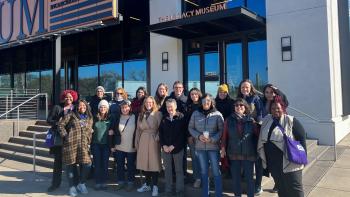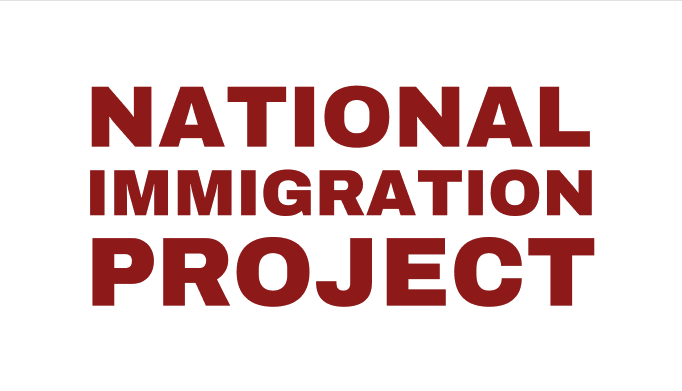In December 2023, with the support of a generous funder, National Immigration Project staff convened in Montgomery, Alabama to visit the Legacy Museum and Memorial. As an organization that works to ensure that those most impacted by the immigration and criminal systems are uplifted and supported, we arrived with a solid understanding of this nation’s history and how that history is the foundation for the laws and systems we navigate when trying to protect our clients and community members. However, even with this understanding, we can say with certainty that our visit to the museum was a deeply impactful and transformational experience for every single one of us.

Throughout our visit, we had support from the Political Healers Project, who helped create a space where we could acknowledge trauma and express our emotions. The following morning, they guided us through a reflective session to debrief on our experience and prepare us to write our own reflections on the feelings the museum evoked in us, the areas of the museum that reminded us of personal experiences, the connections we saw with our current work, and how we plan to incorporate our learnings into our work.
Our staff members shared that the museum brought up many – sometimes conflicting – feelings for them. “It was at once infuriating, incredibly upsetting, overwhelming, exhausting, depressing, and a real kick to the gut - and oh so beautifully made and told,” one staff member shared.
“When I visited the Legacy Museum for a second time, I was not expecting a different experience. I did not expect to be moved to sobs multiple times or to identify parallels to my own personal life,” shared another staff member. Many staff found themselves overwhelmed by the sheer brutality and scale of the history of oppression the museum describes–and we all found ourselves in awe of the people who fought, and continue to fight, to overcome it.
The four areas of the Legacy Museum (enslavement, lynching, segregation and mass incarceration) had clear connections to the current state of policing, criminalization, and immigration in this country. Staff noted parallels with family separation, discrimination, border policy, and mass incarceration.
One staff member shared, “I see . . . parallels between the refusal to legally regularize the millions living in this country without lawful immigration status, forcing them to live increasingly separate lives often in separate communities, always trying to be invisible, and the brutality of the segregation era. To be sure, there are clear and strong differences that set the enslavement, lynching, segregation, and mass incarceration of Black people in this country apart and we absolutely cannot lose sight of that. But I think some relatives of the racist and oppressive ideologies, practices, policies, and laws that drive those have infected our immigration systems as well.”
For many of our staff members who work or have worked directly with immigrants who are detained, the mass incarceration section felt especially distressing. The origin of the immigration detention system that we see today began to expand in the 1980’s along with the mass incarceration of Black and Brown communities. As the U.S. expanded prisons in the 1980s and 1990s, the detention of immigrants, once a little known practice, began to take shape.
“When I came to the phone booths in the mass incarceration portion of the museum, I wasn’t sure that I could sit down at one. I have sat at many such booths in four different jails used as ICE detention centers. I listened to hundreds of people’s deepest traumas through phones just like those, and I told hundreds of people I could not help them. I forced myself to sit and listen. I felt that I owed them my attention; that the museum served not only to educate and persuade, but also to bear witness and memorialize,” shared one staff member.
Another staff member shared, “All four areas of the Legacy Museum really tie into various aspects of the immigration system I engage with in my current work, particularly my work with detained individuals. They are separated from their families, they die within the facilities, and they are placed within spaces that were deemed too terrible to act as jails and prisons. They are viewed as less than.”
Some members on our staff have personal stories that directly connect them to this history. For others, they are currently in marriages or relationships that would have been outlawed at the time.
“As a mother of a young Black boy living in America, the statistics that were shown in the museum made me feel hopeless. Mostly because I know black boys and men are profiled and perceived as a threat as soon as they enter the world. Knowing I can’t fully protect my son from the prejudice and harsh realities of our society hurts. Knowing that 1 in 3 Black men end up incarcerated at some point in their lives, even if they are innocent, leaves me feeling like the word justice is just a meaningless concept,” shared one staff member.
Overall, the Legacy Museum showed us just how much this history affects all of us – and how critical it is for us to not only acknowledge that, but use it to inform our work.
“The visit to the Legacy Museum served as a reminder that as we work to dismantle immigration detention, we must reach across movements and partner with those who have been fighting against mass incarceration, modern day slavery, and convict leasing. These fights are connected, and we are most powerful when we work in community,” shared one staff member.
“I wondered about how we could borrow from the Museum’s approach to narrative-building, powerful storytelling, and community participation to change hearts and minds and disrupt the prevailing narrative in the immigration space. There is so much work to be done, but the Legacy Museum experience–in addition to being painful and overwhelming–was also inspiring and energizing in terms of the possibility that one day we could live in a world where everyone’s humanity and dignity is recognized and valued,” shared another.
In immigration work, we too often are called upon to be less radical, to reach across the aisle and meet people where they are. But some harms call for a radical response. We have to be unapologetically abolitionist when we consider the history of our current systems and the harm they continue to cause today–but to somehow do that in a way that enables connection and growth and learning for people who do not currently share our vision. The visit was a reminder for all of us that the only way to create the change we want to see is to continue working to dismantle the oppressive structures that are rooted so deeply in our immigration and criminal legal systems, and to continue the long hard fight of winning hearts and minds so we can achieve real healing and transformation.
